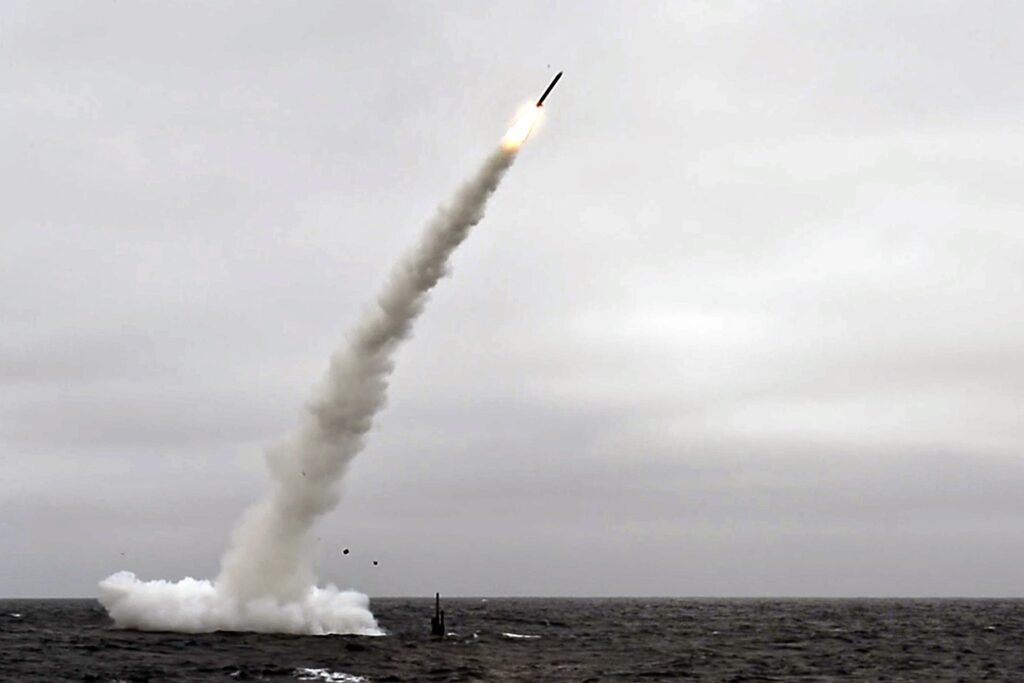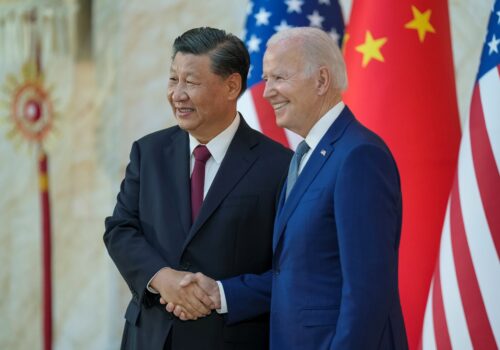Six years after the 2018 Nuclear Posture Review recommended a nuclear armed sea-launched cruise missile (SLCM-N) to counter the growing Russian and Chinese nuclear threat, the program is finally underway, according to recent congressional testimony by administration officials. By authorizing and funding the SLCM-N, Congress took a very important step toward bolstering nuclear deterrence in an increasingly dangerous world. But it must now pay attention to how the Department of Defense executes its decision in the coming years.
There are forces at play—bureaucratic, budgetary, and programmatic—that could stymie the SLCM-N if Congress does not keep an eye on its progress and, at times, push its development in certain directions. For example, US lawmakers should press officials to examine the suitability of existing missiles, or those under development, as starting points to build from. This could help control the potential for high costs and extended schedules. Likewise, Congress should ensure that the Department of Defense does not generate such onerous military requirements for the SLCM-N that the perfect becomes the enemy of the good.
Why the US needs the SLCM-N
The SLCM-N is a cruise missile launched from surface ships or attack submarines (SSNs)—not from ballistic missile submarines. The United States deployed these missiles on SSNs during the Cold War, but they were removed from service (along with most US tactical nuclear weapons) and eventually retired by 2010.
The decision to reintroduce the SLCM-N was not taken lightly in the 2018 Nuclear Posture Review; it was evaluated for need, cost, the burden on the US Navy, and how it might affect other nuclear modernization programs then underway. The expansion of Russian and Chinese regional nuclear forces made this decision necessary. Russia maintains about two thousand “tactical” nuclear weapons that can be deployed on land, at sea, and delivered by aircraft. China possesses about one thousand regional missiles that can be armed with conventional or nuclear warheads. None of these weapons are limited by treaty, and they far exceed US regional nuclear capabilities—a disparity noticed by US allies.
The SLCM-N would be the first new nuclear weapon introduced by the United States since the end of the Cold War, sending a strong message of deterrence to potential adversaries (and reassurance to allies) that the United States has the resolve and range of capabilities to respond to any nuclear use—limited or otherwise. It would signal to Russia and China that, despite their numerical advantage in regional nuclear weapons, there can be no coercive or military advantage gained by threatening the use of a nuclear weapon against the United States or its allies, while the risks of doing so would be unimaginably high.
The SLCM-N was recommended early in 2018, but it took several years for officials to complete the military requirements and conduct an analysis of alternatives. By this point, there was a new administration, and the Biden administration’s Nuclear Posture Review (NPR) reversed the SLCM-N decision in 2022. While there was no disagreement over the regional nuclear threat or the need to counter adversary limited nuclear use, the Biden NPR concluded that the threat could be handled with existing—and soon to be modernized—nuclear forces, thereby avoiding the costs of a new program.
Congress, however, took a different view. After two years of debate with the Biden administration, it passed, on a bipartisan basis, the National Defense Authorization Act for Fiscal Year 2024 with instructions to begin the SLCM-N program and achieve operational capability of the SLCM-N by 2034. The bill was accompanied by appropriations to start the program. Support for the SLCM-N from senior military officials, including a chairman of the Joint Chiefs of Staff and two commanders of US nuclear forces, combined with a favorable mention by the bipartisan Congressional Commission on the Strategic Posture of the United States and a deteriorating security environment likely clinched the deal.
How Congress can ensure an SLCM-N “sweet spot”
Building the SLCM-N will not be easy. The Department of Defense and the National Nuclear Security Administration (NNSA) are already stretched thin executing the replacement programs for aging US nuclear weapons. This includes an intercontinental ballistic missile, nuclear-powered ballistic missile submarine, strategic bomber, and an air-launched nuclear-armed cruise missile. Yet, there may be ways to develop and deploy the SLCM-N in a cost-bearable manner that causes the least amount of disruption to ongoing modernization programs and does not interfere with submarine operations. Finding this “sweet spot” among competing military requirements, production capacity, cost, and operational considerations is key to a successful outcome.
Here’s what Congress should pay attention to during this hearing cycle:
First, program success depends on a competent and fully staffed program office. Congress has directed that decision authority reside with the under secretary of defense for acquisition and sustainment, but the US Navy will execute the program. Congress needs to know when the program office will be stood up, how it will be manned, and if sufficient funding will be provided. ($130 million is provided in fiscal year 2024, but there does not yet appear to be funding requested for fiscal year 2025.)
Second, Congress should ensure that the Department of Defense builds on the work already in process for the SLCM-N. Left to its own devices, there might be a temptation for the defense bureaucracy to take another look at military requirements and conduct a new analysis of alternatives. But this temptation should be resisted, as this work was done by the previous administration.
Third, the Department of Defense should not start from scratch. Significant costs can be avoided by modifying existing or planned missiles rather than commencing a new developmental program. The Long Range Stand Off missile (LRSO)—a replacement for the current air-launched cruise missile—is already under development and may be adaptable for use on a submarine. Likewise, the US Navy should evaluate whether the current fifth-generation Tomahawk sea-launched cruise missile could be suitable for this role. After all, a previous version was employed with a nuclear warhead during the Cold War. The W80-4 warhead, now under development by NNSA for the LRSO, could be adapted for use in the SLCM-N. These are important lines of inquiry for Congress.
Congress will be instrumental in the Department of Defense finding the sweet spot among requirements, costs, and operations. For example, the currently fielded air-launched cruise missile and Tomahawk sea-launched cruise missile both have a range of approximately 1,000 to 1,500 miles; therefore, the Pentagon should not establish a military requirement for a missile with a range of 2,000-plus miles, unless it is absolutely necessary. Analysis has been done to show that the SLCM-N’s contribution to nuclear deterrence can be made at these shorter ranges. Likewise, the US Navy should determine the most effective way to deploy the missile on submarines to ease the operational burden on crews, allow the submarine to continue its conventional power-projection mission, and still provide maximum nuclear deterrent effect against the potential adversary.
Finally, senior US military leadership must stay focused on this project—and on achieving it in parallel with other projects. Nuclear modernization is a priority for the Department of Defense—there is no doubt about that. But the addition of another nuclear acquisition program will further strain management, funding, and attention. Ensuring no harm is done to schedules for the ongoing nuclear modernization programs must be a priority.
After much delay, the SLCM-N is moving forward. Congress and the Department of Defense must now work together to see the project through to completion.
Robert M. Soofer is a senior fellow in the Forward Defense program of the Atlantic Council’s Scowcroft Center for Strategy and Security, where he leads the Nuclear Strategy Project. He served as deputy assistant secretary of defense for nuclear and missile defense policy from 2017 to 2021.
Further reading
Tue, Oct 18, 2022
Bowing to Putin’s nuclear blackmail will make nuclear war more likely
UkraineAlert By Andriy Zagorodnyuk
Giving in to Putin’s nuclear blackmail would not end the war in Ukraine. What it would do is set a disastrous precedent that makes a future nuclear war far more likely while encouraging uncontrolled nuclear proliferation.
Fri, Feb 2, 2024
Requirements for nuclear deterrence and arms control in a two-nuclear-peer environment
Report By
Gregory Weaver and Amy Woolf discuss the future of US nuclear posture and arms control, as the United States will soon face two adversaries with peer nuclear arsenals.
Thu, Feb 15, 2024
Experts react: What to know about Russia’s apparent plans for a space-based nuclear weapon
Experts react By
Reports that Russia is developing a space-based nuclear anti-satellite weapon have raised national security concerns in Washington.
Image: PACIFIC OCEAN (June 27, 2018) The crew of the Los Angeles-class fast attack submarine USS Annapolis (SSN 760) launch a Tomahawk Land Attack Missile (TLAM) off the coast of Southern California as part of a Tomahawk Flight Test (TFT). (US Navy photo by Mass Communication Specialist 1st Class Ronald Gutridge/Released)180627-N-UK333-014



